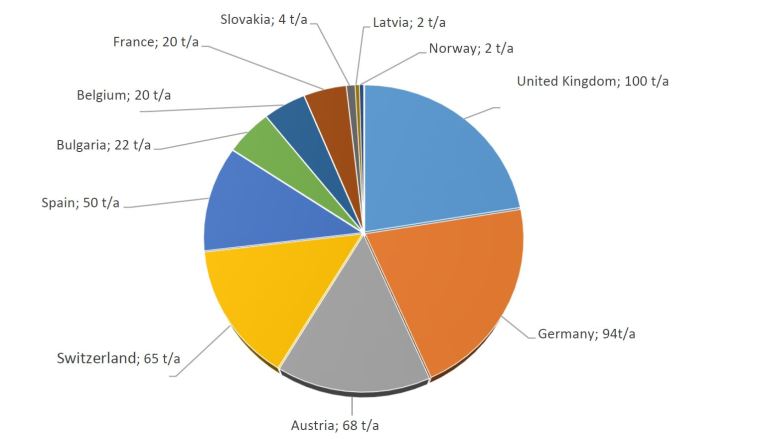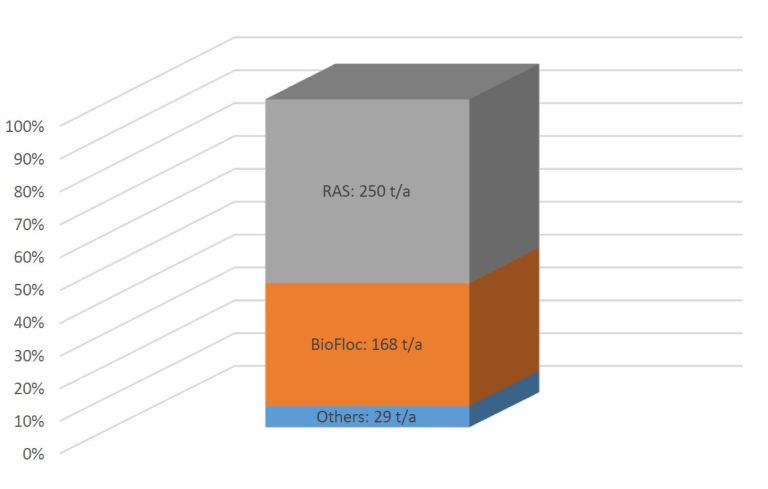European Shrimp Production
Dear EuroShrimp Community Members,
Interest in European shrimp aquaculture remains on a high and we regularly receive inquiries about the status and production levels in Europe. Euroshrimp, together with the company Förde Garnele, conducted a survey on the production volumes in Europe (we included Norway, Switzerland and United Kingdom). We focused on land-based aquaculture to get an insight into the status of this rapidly growing sector. Pond farms, which are located in Mediterranean countries and are usually stocked once in spring and harvested at the end of summer, are not taken into account. We very much welcome input on these systems from anyone willing to pass it on.
By far, the main produced species is the White Tiger Shrimp (L. vannamei) but other species such as the Blue Shrimp (L. stylirostris) and the Kuruma Shrimp (M. japonicus) are found in European shrimp production. Altogether, we identified 13 European countries where a total of 447 tons of shrimp are produced each year (Figure 1). However, it can be assumed, that the total quantity is somewhat higher, as we did not obtain annual production figures from all production sites.
| Figure 1: Shrimp production volumes of European countries 2020. Farms located in Lithuania and Sweden are not included in this Figure, as we do not have any production volumes for these countries. |

The most prevalent form of shrimp production facilities are recirculating aquaculture systems (RAS) producing about 250 tonnes and BioFloc systems about 168 tonnes per year. Nonetheless, new and alternative approaches are to be found in European shrimp farming. In addition to the combination of the previous mentioned methods, there are also approaches in which shrimp are combined with plants to form aquaponic systems.

| Figure2: European Shrimp Production in 2020, divided according to production form. “Other†include: Shrimp Aquaponic (20 t/a); combination of RAS & BioFloc (8 t/a); NA (1 t/a) |
These production volumes illustrate a growing effort to meet demand for fresh and sustainably produced shrimp in Europe. This will probably continue to increase in the future as many of the 24 European shrimp farms we identified have only been established within the last 10 to 15 years. In addition, latest developments in the Hatchery sector indicate, that entrepreneurs and stakeholders also have a positive view of the potential of European shrimp production as they have recognised the need for an import-independent and sustainable shrimp production in Europe.
As always, we have tried to provide as complete a picture as possible of the shrimp aquaculture in Europe, but we cannot guarantee the completeness of the available data. If we have not included countries or production sites in our study that you know of, we would appreciate your feedback to update the datasets and keep them current.
Kind wishes and all the best from The EuroShrimp Team
P.S.: Please feel free to get in contact if you have any news, questions or information you would like to share via the EuroShrimp network. You contact us via the euroshrimp.net website, the new Forum or send an Email to euroshrimp@awi.de

Proposed by ALFRED-WEGENER-INSTITUT | Helmholtz Centre for Polar and Marine Research | Section of KNOWLEDGE AND TECHNOLOGY TRANSFER | AQUACULTURE RESEARCH GROUP